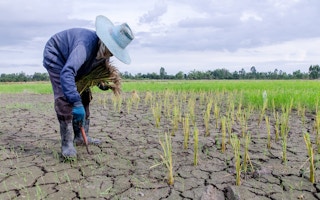As climate change threatens a doubling of the impact of extreme drought and fire within a generation, researchers are uncovering the influence of human activity on both these growing risks.
One study has found that human numbers exposed to the hazard of extreme drought are likely to double in the decades to come, as global heating bakes away the groundwater and limits annual snowfall.
Another team of researchers says the risks of extreme wildfire could also rise twofold in the next 40 years in the Mediterranean, southern Africa, eastern North America and the Amazon. In those places already severely scorched by frequent fire − western North America, equatorial Africa, south-east Asia and Australia − hazards could rise by 50 per cent.
And a third, separate study warns that global temperature rise will shift the patterns of rainfall around the tropics − with the consequent risks to tropical crop harvests and to equatorial ecosystems such as rainforest and savannah.
All three studies are reminders of the intricacies of the planetary climate system and the impact of human action in the last hundred years.
An international research team reports in the journal Nature Climate Change that it looked at the simple problem of global terrestrial water storage: all the moisture in the canopies of forest trees, in the mountain snows and ice, in the lakes, rivers, wetlands, and in the soil itself.
This wealth of stored water is a big player in the patterns of global flooding and drought in the monsoon climates and the arid lands alike. But, the researchers say, there has so far been no study of the potential impact of global climate change on global terrestrial water storage overall.
So researchers from the US, China, Japan and Europe began modelling tomorrow’s world. And they found that, while 3 per cent of the planet’s people were vulnerable to extreme drought in the timespan from 1976 to 2005, later in the century this proportion could increase to 7 per cent or even 8 per cent.
“More and more people will suffer from extreme droughts if a medium-to-high level of global warming continues and water management is maintained in its present state,” warned Yadu Pokhrel, an engineer at Michigan State University, who led the research.
“Areas of the southern hemisphere, where water scarcity is already a problem, will be disproportionately affected. We predict this increase in water scarcity will affect food security and escalate human migration and conflict.”
Fire chances increased
Australia is a southern hemisphere country that knows about water scarcity: its wildfires in 2019 broke all records and sent a vast cloud of smoke to an altitude of 35 kms.
And, on the evidence of a new study in the journal Nature Communications, it won’t be the last such extreme event. Californian scientists, struck by the scale and intensity of Californian wildfires in 2017 and 2018, report that they took a closer look at the way greenhouse gas emissions and human land use change have played into the risks of extreme fire weather.
The simple act of setting forests afire to clear land for farm use has amplified the risk of extreme blazes in the Amazon and North America by 30 per cent in the last century. Fires create aerosols that could, by absorbing sunlight, help cool the terrain beneath them − in some zones. But they could also affect rainfall levels and raise the chances of fire. The nature of such impacts varies from place to place.
“South-east Asia relies on the monsoon, but aerosols cause so much cooling on land that they can actually suppress a monsoon,” said Danielle Touma of the University of California at Santa Barbara. “It’s not just whether you have aerosols or not, it’s the way the regional climate interacts with aerosols.”
Aerosols − with other forces − cannot just suppress a monsoon, they can shift rain patterns permanently. The tropics, too, have begun to feel the heat of the moment.
Drought stress rises
The footprint of extreme drought and fire is massive. Californian researchers report in Nature Climate Change that, across two thirds of the globe, the tropical rainbelt is likely to shift north over eastern Africa and the Indian Ocean to cause more drought stress in south-eastern Africa and Madagascar and intensified flooding in south Asia.
In the western hemisphere, however, as the Gulf Stream current and the North Atlantic deep water formation weaken, the rain belt could move south to bring greater drought stress to Central America.
And once again, climate change driven by global heating is at work with other human influences to alter what had for most of human history been a stable pattern of climate.
“In Asia, projected reductions in aerosol emissions, glacier melting in the Himalayas and loss of snow cover in northern areas brought on by climate change will cause the atmosphere to heat up faster than in other regions,” said James Randerson of the University of California, Irvine, one of the authors.
“We know the rainbelt shifts towards this heating, and that its northward movement in the eastern hemisphere is consistent with these expected impacts of climate change.”
This story was published with permission from Climate News Network.








